
A 17-year-old high school athlete was anxious about this new “mole” that appeared on the heel of his right foot. His concern was prompted by the recent diagnosis of melanoma in his aunt.
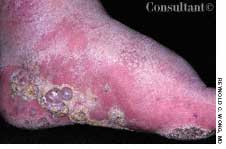

A 17-year-old high school athlete was anxious about this new “mole” that appeared on the heel of his right foot. His concern was prompted by the recent diagnosis of melanoma in his aunt.

After 3 months of seeing this painless mass at the angle of the 3-year-old's left jaw, his parents sought medical advice for their son. The youngster had no constitutional symptoms. A Mantoux test was performed, and an erythematous, indurated area measuring 15 mm in diameter was found at the test site 48 hours later.

Concerned about a lesion between her eyes, a 91-year-old woman sought medical evaluation. She had not seen a physician for 23 years.

A boy was born to a gravida 2, para 1, 26-year-old woman at 37 weeks' gestation. The pregnancy had been complicated by gestational diabetes.
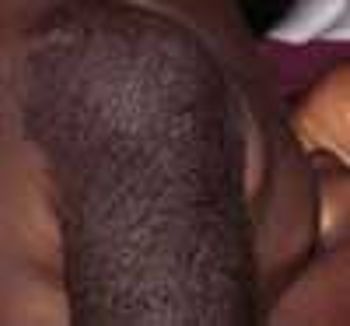
The pigmented hairy nevus that covers the entire right upper arm of this 18-month-old boy has been present since birth. More than 95% of large, congenital pigmented nevi have a hairy component.

This erythematous, papulovesicular eruption developed in a hospitalized patient who had a febrile illness that was accompanied by drenching sweats. Miliaria rubra, or prickly heat, is caused by sweat trapped in obstructed eccrine glands of the epidermis. Inflammation, irritation, and pruritus can occur along with the rash.
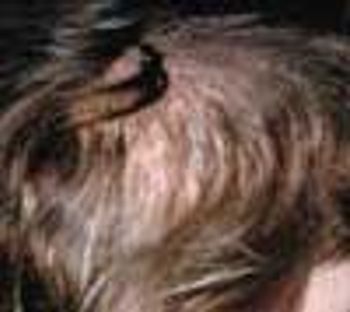
An otherwise healthy 34-year-old woman was concerned because of the abrupt onset of rapid hair loss, accompanied by scaling of the underlying skin. The disorder had begun 3 months earlier, and the right parietal and temporal areas were now red and swollen and had adherent scale. An antinuclear antigen titer was negative. Biopsy revealed changes consistent with lichen planus of the scalp, also known as lichen planopilaris and lichen planus follicularis.

A mildly itchy, tender “red bump” on his eyelid concerned a 68-year-old man. Two years earlier, a basal cell carcinoma, which started as a “red bump,” had been removed from his cheek. This lesion had been present for 2 weeks; the patient noted a small amount of discharge at the site in the mornings.
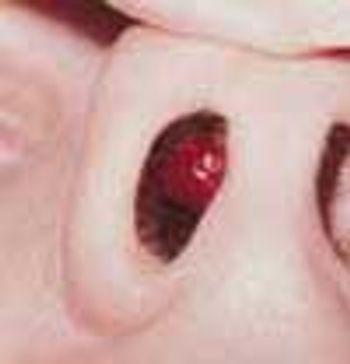
A 21-year-old woman had suffered recurrent nosebleeds and pain in her nose for the previous 2 months. Physical examination revealed an extremely vascular, slowly enlarging intranasal growth on the anterior surface of the septum.

A 10-year-old boy presented with a 6-month history of a painless mass on the left side of the scrotum. The overlying skin had a bluish discoloration. The mass felt like a “bag of worms.” When the boy stood, venous varicosity could be palpated along the spermatic cord. This venous distention increased when he performed Valsalva's maneuver and decreased when he was recumbent.

A 76-year-old man reported a 3-month history of an asymptomatic, raised, reddened lesion on his penis. The patient had type 2 diabetes mellitus. In 1994, a basal cell carcinoma had been excised from his chest and, 3 years later, a squamous cell carcinoma was excised from his left temple.
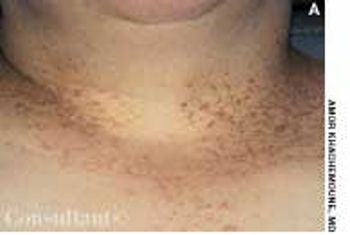
A 42-year-old woman presented with a papular eruption that first appeared during childhood. Severe pruritus, which worsened during the summer, accompanied the lesions. The patient reported that family members, including her mother and brother, had a similar skin problem.

A 44-year-old woman was being seen regularly for skin manifestations of systemic lupus erythematosus (SLE). During a routine visit, blotchy erythema and hyperpigmentation were noted on the normally exposed areas of her neck and upper chest; the submental area was spared. Close examination revealed fine telangiectases and poorly marginated hyperpigmented and hypopigmented macules.

A 28-year-old man presented to the emergency department with a 1-week history of multiple, concentric, erythemic, targetlike plaques over the entire body. Severe necrosis and hemorrhagic crusting were evident on the oral mucosa and lesions were present on the upper lip. The remainder of the physical examination was unremarkable. The patient had no known medical problems, was seronegative for HIV, and denied a history of herpes simplex virus (HSV) infection. He used no medications.
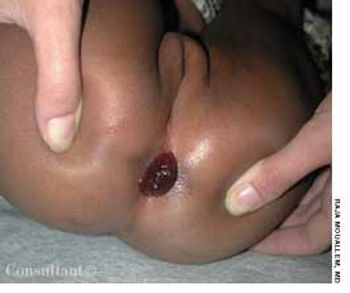
A 2-year-old girl presents to the pediatric emergency department (ED) for evaluation of a fleshy mass protruding from her rectum. The mass, which had been present for 1 day, protruded spontaneously and not during defecation. There is no history of cough, constipation, diarrhea, vomiting, weight loss, or parasitic or chronic disease. However, the child has been having episodic, painless bleeding during the past month. There is no family history of GI disease.

A 56-year-old man had an asymmetric, maculopapular, sharply demarcated, pruritic, excoriated dermatitis on his upper thighs. The eruption had been present for 2 to 3 weeks.
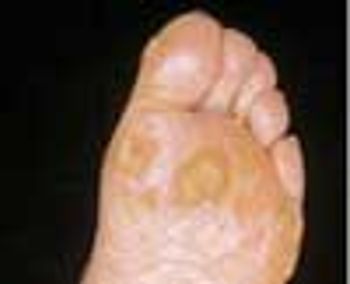
A 63-year-old farmer first noticed multiple rough bumps on his hands and feet at least 20 years before pointing them out to his physician. A diagnosis of arsenical keratoses was made after the patient reported that as a child he had worked on his family's potato farm, where a commonly used pesticide, “Paris Green,” was applied to the plants. The active ingredient in this pesticide was inorganic arsenic.

A 40-year-old man requested evaluation of several cherry-red papules, which he had noticed on the upper part of his trunk for the past 12 months. The eruptions were diagnosed as cherry angiomas, also known as Campbell de Morgan spots.
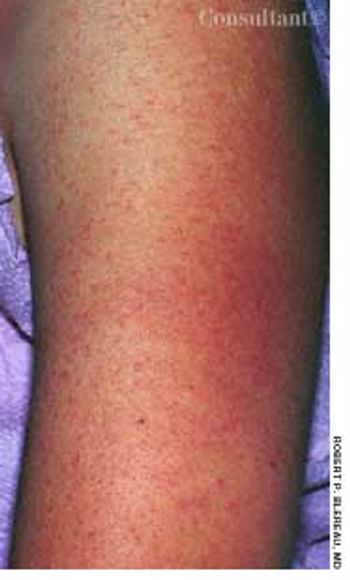
Tiny, asymptomatic "bumps" had been present for 4 years on the posterolateral surface of the upper arms of a 34-year-old woman. Similar but less severe eruptions also appeared on her forearms and anterior thighs.
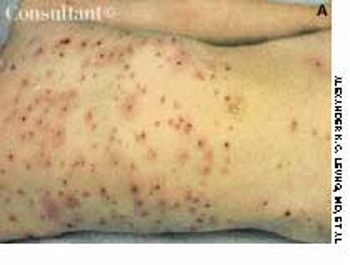
A pruritic, erythematous rash developed in a 6-year-old boy over the previous 5 days. The rash erupted in crops; the lesions appeared initially as rose-colored macules, progressed rapidly to papules and vesicles, and finally crusted. The distribution of the lesions-with the greatest concentration on the trunk-is typical of chickenpox.
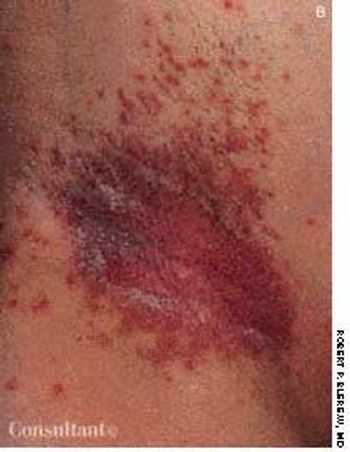
The erythematous rash with punctate satellite lesions seen on the axillary and inframammary areas of a 46-year-old woman are typical of the lesions of moniliasis, or candidiasis. The patient reported that the pruritic rash had erupted 2 months earlier and worsened during the summer heat.
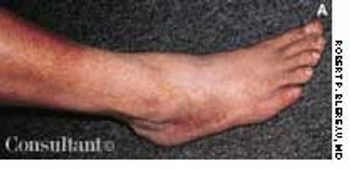
These orange-to-brown macules with red puncta, or cayenne pepper spots, are typical of Schamberg's disease (progressive pigmented purpuric dermatosis). The cause of this disorder is unknown, but it may be related to a cellular immune reaction or drug reaction.
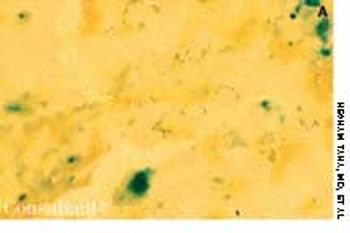
A 70-year-old woman with a history of ischemic heart disease was hospitalized because of generalized weakness, fatigue, and retrosternal chest pain on mild exertion. Her skin was pallid. Chest and heart evaluations were normal, and mild hepatosplenomegaly was discerned.

Fibroadenomas are the most common benign solid tumors of breast tissue. They may develop at any time after puberty, but they are found most frequently in women in their 20s and 30s and are more common than cysts among women aged 25 or younger.
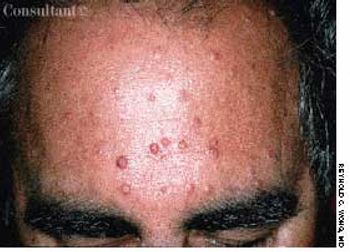
Asymptomatic facial and truncal papules began developing several years before this 55-year-old man sought medical care. The lesions were slightly yellowish or reddish, and many had a central punctum. Biopsy revealed a microscopic picture consistent with sebaceous adenoma.